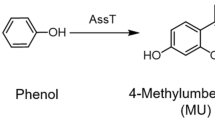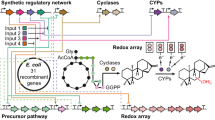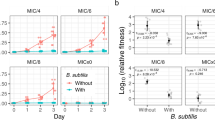Abstract
Microorganisms typically used to produce food and pharmaceuticals are now being explored as medicines and agricultural supplements. However, maintaining high viability from manufacturing until use remains an important challenge, requiring sophisticated cold chains and packaging. Here we report synthetic extremophiles of industrially relevant gram-negative bacteria (Escherichia coli Nissle 1917, Ensifer meliloti), gram-positive bacteria (Lactobacillus plantarum) and yeast (Saccharomyces boulardii). We develop a high-throughput pipeline to define species-specific materials that enable survival through drying, elevated temperatures, organic solvents and ionizing radiation. Using this pipeline, we enhance the stability of E. coli Nissle 1917 by more than four orders of magnitude over commercial formulations and demonstrate its capacity to remain viable while undergoing tableting and pharmaceutical processing. We further show, in live animals and plants, that synthetic extremophiles remain functional against enteric pathogens and as nitrogen-fixing plant supplements even after exposure to elevated temperatures. This synthetic, material-based stabilization enhances our capacity to apply microorganisms in extreme environments on Earth and potentially during exploratory space travel.
This is a preview of subscription content, access via your institution
Access options
Access Nature and 54 other Nature Portfolio journals
Get Nature+, our best-value online-access subscription
27,99 € / 30 days
cancel any time
Subscribe to this journal
Receive 12 print issues and online access
269,00 € per year
only 22,42 € per issue
Buy this article
- Purchase on SpringerLink
- Instant access to full article PDF
Prices may be subject to local taxes which are calculated during checkout





Similar content being viewed by others
Data availability
Data generated or analysed during this study are included in the Supplementary Information. Further data are available from the corresponding author upon request. Source data are provided with this paper.
Code availability
The customized code used for liquid handling and image analysis is available from the corresponding author upon request.
References
Vitorino, L. C. & Bessa, L. A. Technological microbiology: development and applications. Front. Microbiol. 8, 827 (2017).
Ozdemir, T., Fedorec, A. J. H., Danino, T. & Barnes, C. P. Synthetic biology and engineered live biotherapeutics: toward increasing system complexity. Cell Syst. 7, 5–16 (2018).
Arif, I., Batool, M. & Schenk, P. M. Plant microbiome engineering: expected benefits for improved crop growth and resilience. Trends Biotechnol. 38, 1385–1396 (2020).
Menezes, A. A., Cumbers, J., Hogan, J. A. & Arkin, A. P. Towards synthetic biological approaches to resource utilization on space missions. J. R. Soc. Interface 12, 20140715 (2015).
Jimenez, M., Langer, R. & Traverso, G. Microbial therapeutics: new opportunities for drug delivery. J. Exp. Med. 216, 1005–1009 (2019).
Hyronimus, B., Le Marrec, C., Hadj Sassi, A. & Deschamps, A. Acid and bile tolerance of spore-forming lactic acid bacteria. Int. J. Food Microbiol. 61, 193–197 (2000).
Prakash, O., Nimonkar, Y. & Shouche, Y. S. Practice and prospects of microbial preservation. FEMS Microbiol. Lett. 339, 1–9 (2013).
Morgan, C. A., Herman, N., White, P. A. & Vesey, G. Preservation of micro-organisms by drying; a review. J. Microbiol. Methods 66, 183–193 (2006).
Kurtz, C. et al. Translational development of microbiome‐based therapeutics: kinetics of E. coli Nissle and engineered strains in humans and nonhuman primates. Clin. Transl. Sci. 11, 200–207 (2018).
Gurbatri, C. R. et al. Engineered probiotics for local tumor delivery of checkpoint blockade nanobodies. Sci. Transl. Med. 12, eaax0876 (2020).
Adejare, A. (ed.) Remington: The Science and Practice of Pharmacy 23rd edn (Academic Press, 2020).
Rowlett, V. W. et al. Impact of membrane phospholipid alterations in Escherichia coli on cellular function and bacterial stress adaptation. J. Bacteriol. 199, e00849–16 (2017).
Bogdanov, M., Dowhan, W. & Vitrac, H. Lipids and topological rules governing membrane protein assembly. Biochim. Biophys. Acta 1843, 1475–1488 (2014).
Sonnenborn, U. & Schulze, J. The non-pathogenic Escherichia coli strain Nissle 1917 – features of a versatile probiotic. Microb. Ecol. Health Dis. 21, 122–158 (2009).
Connor, T. R. et al. Species-wide whole genome sequencing reveals historical global spread and recent local persistence in Shigella flexneri. eLife 4, e07335 (2015).
Lapierre, L. et al. Phenotypic and genotypic characterization of virulence factors and susceptibility to antibiotics in Salmonella Infantis strains isolated from chicken meat: first findings in Chile. Animals 10, 1049 (2020).
Shad, A. A. & Shad, W. A. Shigella sonnei: virulence and antibiotic resistance. Arch. Microbiol. 203, 45–58 (2021).
Long, S. R. Rhizobium-legume nodulation: life together in the underground. Cell 56, 203–214 (1989).
Ivanova, E. P. & Skalozub, O. M. The effectiveness of the use of Sinorhizobium meliloti in the cultivation of variable alfalfa (Medicago varia Mart.). IOP Conf. Ser. Earth Environ. Sci. 962, 012017 (2022).
Deaker, R., Roughley, R. & Kennedy, I. Legume seed inoculation technology—a review. Soil Biol. Biochem. 36, 1275–1288 (2004).
Pedrini, S., Merritt, D. J., Stevens, J. & Dixon, K. Seed coating: science or marketing spin? Trends Plant Sci. 22, 106–116 (2017).
Doses in Our Daily Lives (United States Nuclear Regulatory Commission, accessed 10 November 2022); https://www.nrc.gov/about-nrc/radiation/around-us/doses-daily-lives.html
Zhang, S. et al. First measurements of the radiation dose on the lunar surface. Sci. Adv. 6, eaaz1334 (2020).
Zeitlin, C. et al. Overview of the Martian radiation environment experiment. Adv. Space Res. 33, 2204–2210 (2004).
Hassler, D. M. et al. Mars’ surface radiation environment measured with the Mars Science Laboratory’s Curiosity rover. Science 343, 1244797 (2014).
Dachev, T. P. et al. Overview of the ISS radiation environment observed during the ESA EXPOSE-R2 mission in 2014–2016. Space Weather 15, 1475–1489 (2017).
Lambert, P. A. in Russell, Hugo & Ayliffe’s Principles and Practice of Disinfection, Preservation and Sterilization 5th edn (eds Fraise, A. P. et al.) 294–305 (John Wiley & Sons, 2013).
Matin, A., Auger, E. A., Blum, P. H. & Schultz, J. E. Genetic basis of starvation survival in nondifferentiating bacteria. Annu. Rev. Microbiol. 43, 293–316 (1989).
Wasuwanich, P., Fan, G., Burke, B. & Furst, A. L. Metal-phenolic networks as tuneable spore coat mimetics. J. Mater. Chem. B 10, 7600–7606 (2022).
Milo, R., Jorgensen, P., Moran, U., Weber, G. & Springer, M. BioNumbers—the database of key numbers in molecular and cell biology. Nucleic Acids Res. 38, D750–D753 (2010).
Abràmoff, M. D., Magalhães, P. J. & Ram, S. J. Image processing with ImageJ. Biophotonics Int. 11, 36–42 (2004).
<1216> Tablet Friability (United States Pharmacopeia, 2023); https://doi.org/10.31003/USPNF_M99935_02_01
<2091> Weight Variation of Dietary Supplements (United States Pharmacopeia, 2019); https://doi.org/10.31003/USPNF_M99985_02_01
<701> Disintegration (United States Pharmacopeia, 2019); https://doi.org/10.31003/USPNF_M99460_03_01
<1217> Tablet Breaking Force (United States Pharmacopeia, 2019); https://doi.org/10.31003/USPNF_M99937_02_01
Sugawara, M. & Sadowsky, M. J. Enhanced nodulation and nodule development by nolR mutants of Sinorhizobium medicae on specific Medicago host genotypes. Mol. Plant Microbe Interact. 27, 328–335 (2014).
Barker, D. et al. Medicago truncatula Handbook (The Samuel Roberts Noble Fondation, 2006).
Legume-Microbe Interactions Laboratory. Protocol for Nodulation Assay in Pouches (Univ. Missouri, accessed 15 October 2020); https://staceylab.missouri.edu/protocol-nodulation-assay-pouches/
Acknowledgements
We thank R. Langer for providing guidance, feedback and experimental facilities; B. Fields and C. Voigt for the enteric pathogen cultures; M. Ericsson at the HMS Electron Microscopy Core for the transmission electron microscopy characterization; and A. Hupalowska for creating the illustration in Fig. 4a. Illustrations in Figs. 2a and 5a,b,e and Supplementary Figs. 15 and 16 were created partially with BioRender.com. This work was supported in part by the Translational Research Institute for Space Health through Cooperative Agreement NNX16AO69A through grants awarded to G.T. and M.J.; G.T. was supported in part by the Department of Mechanical Engineering, Massachusetts Institute of Technology (MIT) and the Karl van Tassel (1925) Career Development Professorship, MIT. Part of this material is based on research sponsored by 711 Human Performance Wing (HPW) and Defense Advanced Research Projects Agency (DARPA) under agreement number FA8650-21-2-7120 awarded to G.T. The US Government is authorized to reproduce and distribute reprints for governmental purposes notwithstanding any copyright notation thereon. The views and conclusions contained herein are those of the authors and should not be interpreted as necessarily representing the official policies or endorsements, either expressed or implied, of 711 Human Performance Wing (HPW) and Defense Advanced Research Projects Agency (DARPA) or the US Government.
Author information
Authors and Affiliations
Contributions
M.J. and G.T. conceived and designed the research; M.J. designed the high-throughput pipelines; J.L., Z.V., A.K.-S. and Q.C. established the calibration curves for microbial quantification; M.J. and J.L. designed and performed the commercial probiotics survey; M.J. and J.L. performed the initial material stabilizer evaluations and validations; M.J. and E.K. performed the material stabilizer optimization and validations; M.J. and E.K. designed and performed the synthetic extremophile pharmaceutical manufacturing and viability evaluation; M.J. and J.D.B. designed and performed the ionizing radiation experiment; M.J., J.L. and K.B.M. designed, performed and optimized the plant nodulation assay; G.W.L., H.E. and A.D. designed and performed the in vitro pathogen assays; M.J., G.W.L. and N. Fabian designed the in vivo intestinal pathogen model; M.J., G.W.L., N. Fabian, J.J., N. Fitzgerald and A.D. performed the in vivo pathogen assay; M.Y. performed the blinded quantification of pathogen load; C.K. performed the compendial and non-compendial tests on the bacterial tablets; B.M. performed scanning electron microscopy of the microbial materials; M.J., J.L. and E.K. performed formal analysis of the data; M.J. and G.T. wrote the manuscript; M.J., J.L., E.K. and G.T. edited the manuscript; M.J. and G.T. supervised and managed project progress and personnel; and M.J. and G.T. supervised and managed funding of the project.
Corresponding author
Ethics declarations
Competing interests
M.J., G.T., J.L. and E.K. are co-inventors on patent application 18/477,970 (filed 29 September 2023 by MIT), which describes the microbial-stabilizing materials and processes reported here. M.J. and G.T. consult for VitaKey. The other authors declare no competing interests.
Peer review
Peer review information
Nature Materials thanks Omid Veiseh and the other, anonymous, reviewer(s) for their contribution to the peer review of this work.
Additional information
Publisher’s note Springer Nature remains neutral with regard to jurisdictional claims in published maps and institutional affiliations.
Supplementary information
Supplementary Information
Supplementary Figs. 1–17, Tables 1–4 and Discussion.
Source data
Source Data Fig. 1
Statistical source data.
Source Data Fig. 2
Statistical source data.
Source Data Fig. 3
Statistical source data.
Source Data Fig. 4
Statistical source data.
Source Data Fig. 5
Statistical source data.
Rights and permissions
Springer Nature or its licensor (e.g. a society or other partner) holds exclusive rights to this article under a publishing agreement with the author(s) or other rightsholder(s); author self-archiving of the accepted manuscript version of this article is solely governed by the terms of such publishing agreement and applicable law.
About this article
Cite this article
Jimenez, M., L’Heureux, J., Kolaya, E. et al. Synthetic extremophiles via species-specific formulations improve microbial therapeutics. Nat. Mater. 23, 1436–1443 (2024). https://doi.org/10.1038/s41563-024-01937-6
Received:
Accepted:
Published:
Issue Date:
DOI: https://doi.org/10.1038/s41563-024-01937-6
This article is cited by
-
Living plastics from plasticizer-assisted thermal molding of silk protein
Nature Communications (2025)



